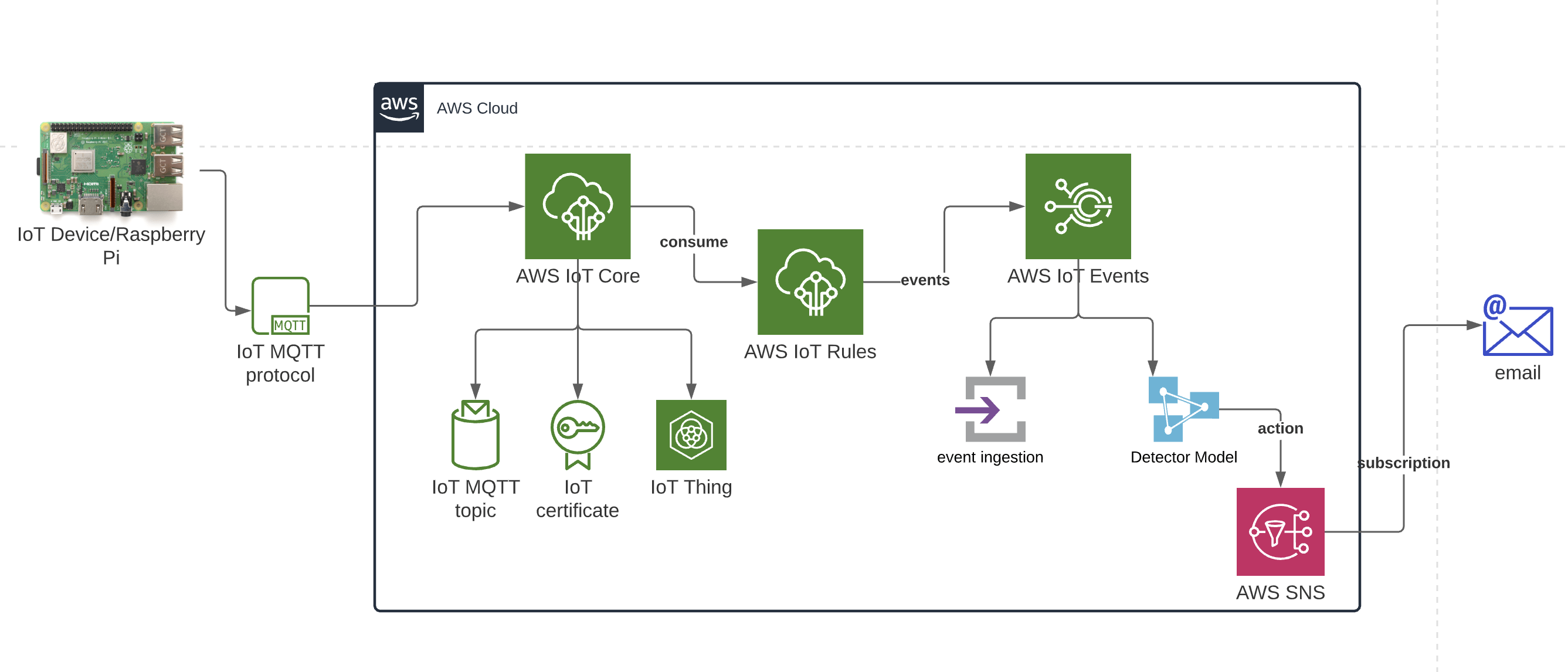Building a Secure and Scalable Remote IoT VPC Network with Raspberry Pi and AWS offers a comprehensive solution for managing IoT devices in a secure and efficient manner. As IoT technology becomes increasingly integrated into everyday life, the demand for robust and scalable network solutions continues to grow. This article delves into the benefits of combining Raspberry Pi, a versatile and affordable single-board computer, with Amazon Web Services (AWS) and Virtual Private Cloud (VPC) to revolutionize IoT infrastructure. By harnessing the power of AWS's cloud capabilities and Raspberry Pi's flexibility, you can design a secure, scalable, and cost-effective IoT network tailored to your specific needs.
In today’s interconnected world, IoT devices are ubiquitous, ranging from smart homes to advanced industrial automation systems. However, managing these devices remotely can be challenging without the right infrastructure and tools. This is where AWS VPC and Raspberry Pi shine. AWS VPC enables you to create a secure and isolated section of the AWS Cloud, while Raspberry Pi acts as an affordable and flexible IoT gateway. Together, they form a powerful foundation for remote IoT management, empowering businesses and individuals alike.
Throughout this article, we will explore the technical intricacies of setting up a remote IoT VPC network using Raspberry Pi and AWS. You will learn how to configure your Raspberry Pi, integrate it with AWS services, and establish a secure VPC environment. Whether you are a developer, IT professional, or IoT enthusiast, this guide will equip you with the knowledge and skills to build a reliable and scalable IoT solution. Let’s dive in!
Read also:Gorilla Glue The Ultimate Guide To Strength And Versatility
Table of Contents
Overview of Remote IoT Management
Remote IoT management involves the monitoring and control of IoT devices from a distance, often through cloud-based platforms. This approach enables users to manage devices, collect data, and perform maintenance without needing to be physically present. Remote IoT management is particularly beneficial in industries such as agriculture, healthcare, and manufacturing, where IoT devices are often deployed in remote or hard-to-reach locations.
One of the primary challenges of remote IoT management is ensuring secure and reliable communication between devices and the central management system. To address this, AWS VPC and Raspberry Pi provide an ideal solution. By creating a private network within AWS and utilizing Raspberry Pi as a gateway, you can ensure that your IoT devices communicate securely and efficiently, minimizing risks and optimizing performance.
Understanding AWS VPC
AWS VPC, or Virtual Private Cloud, is a service provided by Amazon Web Services that allows users to create a logically isolated section of the AWS Cloud. Within a VPC, you can launch AWS resources in a virtual network that you define, giving you full control over your network configuration. This includes setting up IP address ranges, subnets, route tables, and network gateways, enabling you to tailor your network to meet your specific needs.
Utilizing AWS VPC for remote IoT networks provides numerous advantages:
- Enhanced Security: VPC allows you to control access to your IoT devices by setting up security groups and network access control lists (ACLs), ensuring that only authorized entities can interact with your network.
- Scalability: You can easily expand your IoT network by adding more subnets and resources within the VPC, accommodating growth and evolving requirements.
- Customization: You have complete control over your network configuration, including IP addressing and routing, enabling you to create a network that aligns perfectly with your operational needs.
Raspberry Pi as an IoT Solution
Raspberry Pi is a compact, affordable, and versatile single-board computer widely adopted in IoT projects. Its affordability, energy efficiency, and ease of use make it an excellent choice for serving as an IoT gateway. Raspberry Pi can connect to a variety of sensors and devices, process data locally, and communicate seamlessly with cloud platforms like AWS, making it an indispensable component of any IoT infrastructure.
Here are some reasons why Raspberry Pi is well-suited for IoT gateways:
Read also:Exploring Allmovieshub 300mb Your Ultimate Guide
- Flexibility: Raspberry Pi supports multiple programming languages and operating systems, allowing it to adapt to a wide range of IoT use cases and applications.
- Connectivity: It features built-in Wi-Fi and Ethernet ports, enabling seamless communication between IoT devices and cloud platforms, ensuring reliable data transmission.
- Community Support: Raspberry Pi benefits from a large and active community, providing access to tutorials, forums, and open-source projects, making it easier for users to troubleshoot and innovate.
Configuring Raspberry Pi for Remote IoT
Step 1: Installing Raspberry Pi OS
To begin configuring your Raspberry Pi for remote IoT management, you first need to install Raspberry Pi OS. Raspberry Pi OS is a lightweight and efficient operating system specifically designed for Raspberry Pi devices. You can download the latest version from the official Raspberry Pi website and use tools like Balena Etcher to flash it onto an SD card, ensuring your device is ready for deployment.
Step 2: Customizing Network Settings
Once Raspberry Pi OS is installed, the next step is to configure the network settings to ensure your Raspberry Pi can connect to the internet and communicate with AWS. This includes setting up Wi-Fi credentials, assigning a static IP address for consistent connectivity, and enabling SSH for secure remote access. Proper network configuration is crucial for maintaining reliable communication between your IoT devices and the cloud.
Connecting Raspberry Pi to AWS
Integrating Raspberry Pi with AWS involves setting up AWS IoT Core, a service that enables your devices to securely connect to the cloud. You will need to register your Raspberry Pi as an IoT device in AWS IoT Core, generate security certificates, and configure policies to control access, ensuring that only authorized devices can interact with your network.
Here’s a step-by-step guide to help you integrate Raspberry Pi with AWS:
- Create an AWS account and navigate to the IoT Core console to access the necessary tools and services.
- Register your Raspberry Pi as a new IoT device, assigning it a unique identifier within AWS IoT Core.
- Download and install the required certificates and keys on your Raspberry Pi, ensuring secure authentication and communication.
- Use the AWS SDK or CLI to test the connection between your Raspberry Pi and AWS, verifying that everything is functioning as expected.
Establishing a Secure VPC on AWS
To establish a secure VPC for your IoT network, follow these steps:
- Log in to the AWS Management Console and navigate to the VPC dashboard to begin configuring your network.
- Create a new VPC and define the IP address range using CIDR notation, ensuring it aligns with your network requirements.
- Set up subnets, route tables, and internet gateways to facilitate communication between your Raspberry Pi and AWS services, optimizing data flow and connectivity.
- Configure security groups and network ACLs to restrict access to your IoT devices, safeguarding them from unauthorized access and potential threats.
Best Practices for Remote IoT Networking
When setting up a remote IoT network, adhering to best practices is essential for ensuring security, scalability, and reliability. Here are some recommendations to guide you:
- Data Encryption: Encrypt data both in transit and at rest to protect sensitive information from unauthorized access and potential breaches.
- Regular Updates: Keep your Raspberry Pi and AWS services updated with the latest security patches and software updates, ensuring that your network remains secure and resilient.
- Monitoring and Logging: Utilize AWS CloudWatch to monitor your IoT devices and log events for troubleshooting, enabling you to identify and address issues promptly.
Real-World Use Cases
Remote IoT networks powered by Raspberry Pi and AWS have a wide range of real-world applications, transforming industries and enhancing operational efficiency. Some examples include:
- Smart Agriculture: Use IoT sensors to monitor soil moisture, temperature, and humidity levels, and analyze the data in the cloud to optimize crop management and increase yields.
- Healthcare: Track patient vitals remotely and send alerts to healthcare providers in case of abnormalities, improving patient care and response times.
- Industrial Automation: Monitor machinery performance and predict maintenance needs using IoT devices, reducing downtime and optimizing operational efficiency.
Addressing Common Challenges
While remote IoT networks offer numerous benefits, they also present challenges that need to be addressed. Some common issues include:
- Security Risks: Mitigate security risks by leveraging AWS VPC and implementing robust authentication mechanisms, ensuring that only authorized devices and users can access your network.
- Network Latency: Optimize your network configuration to minimize latency and improve performance, ensuring seamless communication between devices and the cloud.
- Scalability Issues: Use AWS Auto Scaling to handle increased traffic and device connections, ensuring your network can grow and adapt as your IoT deployment expands.
Final Thoughts
In conclusion, building a remote IoT VPC network with Raspberry Pi and AWS is a powerful and effective way to manage IoT devices securely and efficiently. By leveraging AWS VPC for network isolation and Raspberry Pi as a gateway, you can create a scalable and cost-effective solution tailored to your IoT needs. This guide has provided you with the knowledge and tools to set up and optimize your remote IoT network, empowering you to take full advantage of IoT technology.
If you found this article insightful, please share it with others who might benefit from it. Feel free to leave a comment below with your thoughts or questions. For more in-depth guides on IoT and cloud computing, explore our other articles on the site. Happy building and innovating!

